Scientific Name
Kaempferia galanga L.
Synonyms
Alpinia sessilis J.Koenig, Kaempferia humilis Salisb., Kaempferia latifolia Donn ex Hornem., Kaempferia marginata Carey ex Roscoe, Kaempferia plantaginifolia Salisb., Kaempferia procumbens Noronha, Kaempferia rotunda Blanco [Illegitimate] [1]
Vernacular Name
| Malaysia | Cekur [2][3], cekur Jawa, kencur [3] |
| English | East Indian galangal, galanga, spice lily, resurrection lily [2], maraba [4] |
| China | Shan-nai [5] |
| India | Kachoram (Tamil; Siddha) [4]; chandra-mula (Hindi); chandramulika, sugandhavacha (Sanskrit); achoram, kacholum, kencur, tjekur [2] |
| Indonesia | Chekur, chengkur, kenchur (Javanese); kencur [2] |
| Thailand | Pro hom, waan hom, waan teendin, khiey, krachai [2] |
| Philippines | Disol, doto, kisol [2] |
| Vietnam | Teu dau [2] |
| Hong Kong | Sarn-noi [5] |
| Japan | Ban-u-kon [5] |
| Germany | Chinenischer galgant, gewürzlilie, kentjur, Thai-ingwer [2]. |
Geographical Distributions
Kaempferia galanga is native to tropical Asia. It is widely cultivated throughout Southeast Asia countries such as Malaysia, Indonesia, Thailand, Vietnam and Cambodia. It can also be found in Southern China, India and Taiwan. [6]
Botanical Description
K. galanga is a member of the Zingiberaceae family. It is a stemless herb arising from tuberous rootstocks with fibrous cylindrical roots. The rhizome has dark reddish-brown skin and the soft interior is nearly white. [6][7]
The leaves usually 2-3(-5), spread horizontally, dark green, broadly elliptical to slightly flat with circular outline, measuring 8-15 cm wide. The blade is often lying flat to the soil, the top surface is smooth while the bottom surface is cobweb-hairy. [6][7]
The inflorescence is sessile, emerging from between the leaves. It is 4-12(-15)-flowered. The sepal is 2-3 cm long. The petal is white, with tube 2.5-5 cm long and lobes 1.5-3 cm long. Their lip is broadly reversed egg-shaped, divided to about halfway or more, white or pale purple with violet to purple spots at the base. Each lateral lobe is about 2-2.5 cm x 1.5-2 cm. Other abortive stamen has an imperfect anther that is oblong-reversed egg-shaped to oblong-lance-shaped, 1.5-3 cm long and white. Their fertile stamen is 10-13 mm long, with two lobes deeply connective with abruptly bent lobes. [7]
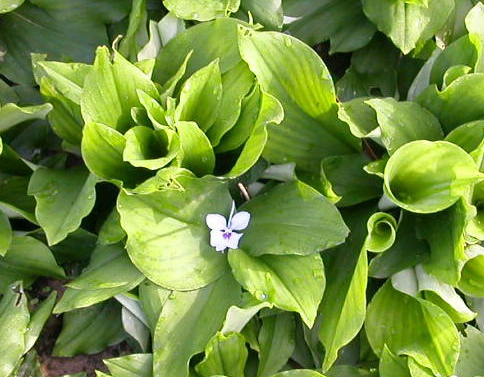
Cultivation
Soil Suitability and Climate Requirement
K. galanga can be cultivated on various soil types but it grows better on soil with high organic matter content, good texture and drainage. It can be planted both in the tropic and subtropic. Under natural growing conditions, the vegetative growth starts at early rainy season and the leaves will be dried up in drought season when the rhizomes start to mature. [6]
Field Preparation
Land Preparation
The planting area has to be disc ploughed at 25-30 cm deep and followed by rotovation to get a good texture soil before planting beds are made. For soil with pH less than five, it must be limed before rotovation to get pH around six using Ground Magnesium Limestone (GML) at the rate of 2-3 t/ha. [6]
Production of Planting Materials
K. galanga is planted using mature rhizomes cuttings having 3-4 leaf buds. The cutting is dipped in fungicide to protect from soil-borne diseases. The rhizome cuttings are pregerminated in growing media before field planting to ensure a good stand in the field. [6]
Field Planting
Field planting should be done at the start of the rainy season. Planting bed is made using bed-former. The bed should be flat on the top measuring about a meter wide and 20 cm high. The planting distance is 25 cm between rows and 20-25 cm within a row. This will give the population density of about 120,000–160,000 plants/ha. ‘Cekur’ can be planted in the open field or slightly shady areas. [6]
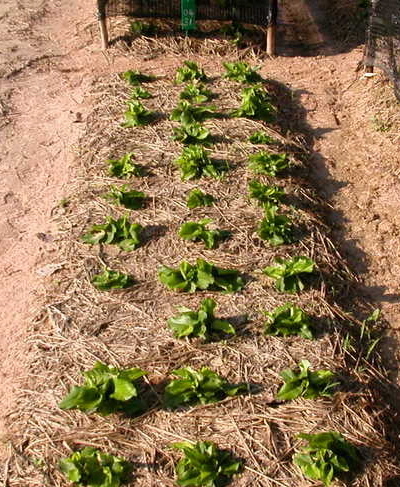
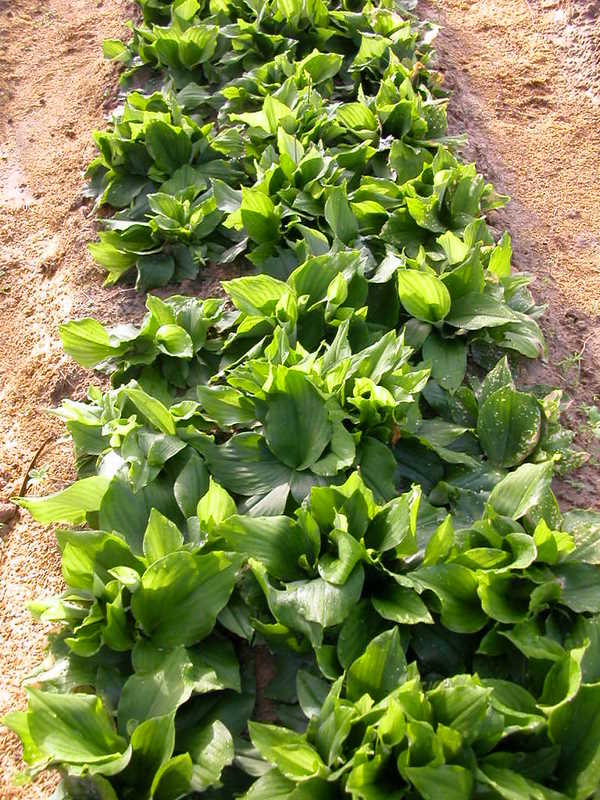
Field maintenance
Fertilisation
Basal fertiliser at the rate of 10 t/ha of processed chicken dung (NPK=4:4:3) is incorporated into the soil 4-5 days before planting. The crops are side-dressed by using the same fertiliser at the rate of 3 t/ha. The side dressing fertilisers should be given between the planting rows at monthly intervals up to five months. [6]
Weed Control
Weeds can be affectively controlled at the early crop stage by using plastic mulch. However, care should be taken to prevent the plastic mulch from disturbing the crop growth. The plastic mulch can be removed when the crop canopy between the hills nearly touch one another. Manual weeding has to be done from time to time to remove weeds. [6]
Water management
For optimum crop growth, supplementary irrigation is needed especially during the dry season. Sprinkler irrigation system is recommended. [6]
Pest and Disease Control
Leaf folding caterpillar (Erionata thrax) normally attacks the crop. It can be controlled by spraying with acephate. Mitex is used to control mites if crops are grown under shady areas. [6]
Harvesting
Young leaves and rhizome of K. galanga are harvested at vegetative stage for dip, salad and other culinary purposes. For medicinal purposes, the mature rhizomes are harvested at 10-11 months after planting. At this stage, the leaf starts to turn yellow and dries. Potential fresh yield is 7-10 t/ha. [6]
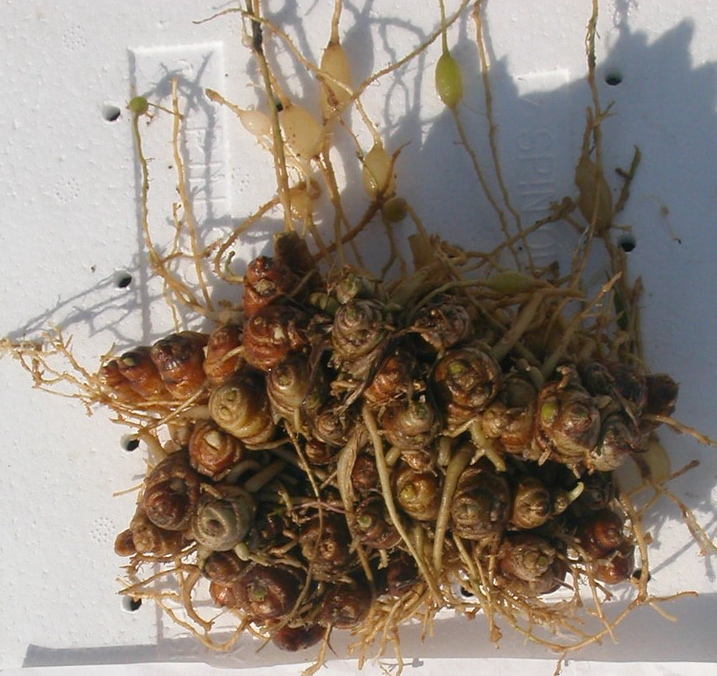
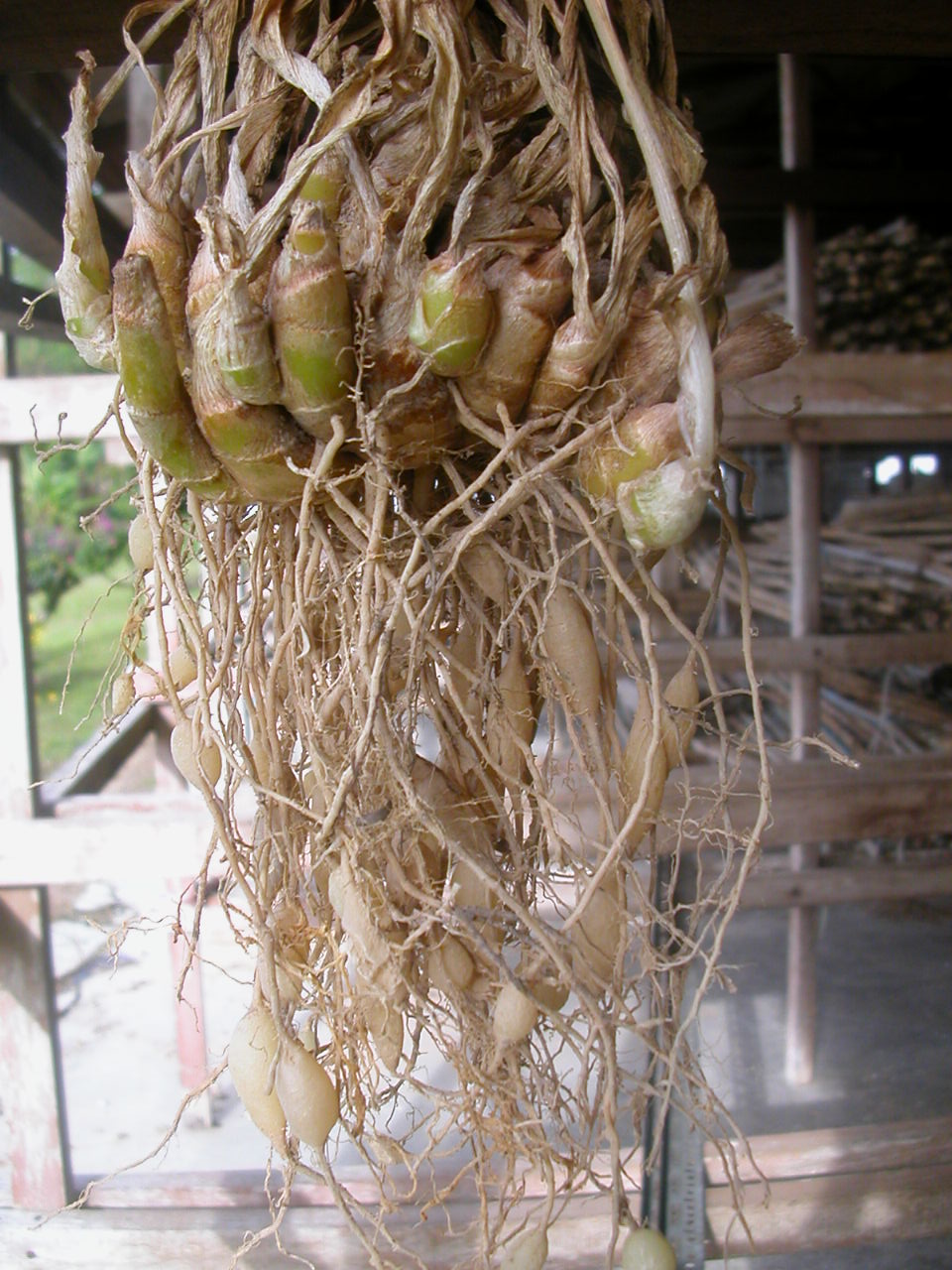
Postharvest handling
Harvested rhizomes are washed and dried at air temperature and sold as fresh rhizomes. For the preparation of traditional medicines and for storage, rhizomes are sliced and dried at 40oC either sun-dried or using the commercial dryer. [6]
Estimated cost of production
The production cost per hectare for land preparation, input and labour is about RM15,530. The production cost per kilogramme depends on the yield per hectare. The production cost of fresh rhizome is between RM1.60/kg (yield 10 t/ha) and RM2.20/kg (yield 7 t/ha). The production cost was estimated based on the cost of current inputs during writing of this article. [6]
Chemical Constituent
Chloroform extract of K. galanga rhizomes has been reported to contain phenylpropanoids (e.g. ethyl cinnamate, ethyl-p-methoxy cinnamate and isopropyl cinnamate), monoterpenes (e.g. methyl isopulegone and dipentene dioxide), coumarin (e.g. 3,7-dimethoxycoumarin), dialkylketones (e.g. undecanone, 9-hydroxy-2-nonanone and 2-heptadecanone) and other miscellaneous compounds(e.g. dicyclohexyl propanedinitrile, (Z)-2,7-octadien-1-yl acetate, ethyl cyclohexyl acetate, cis-11-tetradecenyl acetate, trans,trans–octa-2,4-dienyl acetate, 10-undecyn-1-ol and camphidine). [8]
Dichloromethane extract of K. galanga rhizomes has been reported to contain the phenylpropanoid(e.g.ethyl-p-methoxy cinnamate). [9]
Essential oil of K. galanga rhizomes has been reported to contain monoterpenes (e.g. camphene, camphene hydrate, terpinolene, citral 2, borneol, geranyl-n-heptanoate, 1,8-cineole, δ-carene, and α-pinene), sesquiterpene (e.g. γ-cadinene), coumarin (e.g. 6-methylcoumarin), phenylpropanoids (e.g. isoeugenol, acetyl eugenol, cinnamyl isobutyrate, ethyl cinnamate, ethyl-p-methoxy cinnamate, and salicylate) and other miscellaneous compounds (e.g. 2-cyclohexylcyclohexane, cyclohexenylcyclohexanone, allyl and n-hexyl angelate, isoamyl-hexanoate, n-hexanal, diallyl sulfide, 2-ethoxythiazole, 2-ethyl-4-methylthiazole, hexyl formate, isobutyl disulfate, 2-cyclohexyethyl acetate, isobutyl beta-2-furylacrylate, linoleoyl chloride and pentadecane). [10][11][12]
Volatile oil of K. galanga rhizomes has been reported to contain phenylpropanoids (e.g. ethyl-p-methoxy cinnamate, methyl cinnamate), monoterpenes (e.g. carvone, eucalyptol) and other miscellaneous compounds (e.g. pentadecane). [13][11]
Plant Part Used
Rhizomes and leaves [2]
Traditional Use
The herb is famously used by Asian in their cooking. [14]
The K. galanga rhizome is considered stimulant, carminative, diuretic and expectorant [4][14]. This has rendered its usefulness in the treatment of abdominal pain, flatulence, toothache, vomiting and diarrhoea [14]. The rhizome also possessed anti-inflammatory activity where in the form of powder or ointment, it is used for treatment of wounds and bruises thus reduced the swelling [4]. K. galanga rhizome can be used to treat wind and phlegm, restore digestive heat, and help circulate the blood [15]. The powdered rhizome mixed with honey is an expectorant used to treat productive cough and pectoral affection. Besides, oil prepared from the rhizome is applied over the nasal region to relieve nasal congestion [4]. The preparation also can be used to treat wounds and applied to rheumatic region. [14] Roasted rhizomes are applied as hot poultice in rheumatism [4]. The Thais and Indian used dried rhizomes to treat cardiac complaints. It functions to promote vital energy circulation and alleviate pain. [14] In Philippines, a decoction of the rhizomes is used for dyspepsia, headhache, and malaria [4][14]. A gargle made from a decoction of the rhizome can relieve sorethroat [4]. In Malaysia, a piece of the K. galanga rhizome of the thumb size is chewed with some salt to treat sore throat. They also boiled the rhizome with other roots and used in the treatment of women after childbirth. It is believed to warm the body and can used as a tonic [3]. A lotion prepared from the rhizome is used as antidandruff and to remove scalps from the head [14].
The leaves are used as lotions and poultices to treat sore eyes, rheumatism and fever [14]. In Malaysia, the crushed leaves are used as hot compresses in the treatment of traumatic injuries to reduce the swelling [3].
Preclinical Data
Pharmacology
Hypopigmentary activity
Ethyl p-nethoxyxinnamate compound isolated from the ethanol extract of K. galanga significantly decreased the melanin synthesis in B1610 murine melanoma cells stimulated with alpha-melanocyte stimulating hormone (α-MSH) but did not directly inhibited tyrosinase, the rate-limiting enzyme of melanogenesis. It also decreased microphthalmia-associated transcription factor and tyrosinase levels in α-MSH-stimulated B16F10 cells. This pigment-inhibitory effect was shown to occur via downregulating tyrosinase activity, thus has the probability could be developed as a skin whitening agent to treat hyperpigmentary disorders. [16]
Sedative activity
Crude hexane extract and its two isolated active aromatic compounds of K. galanga namely ethyl trans-p-methoxycinnamate and ethyl cinnamate administered by inhalation in mice showed sedative effects at different doses. Crude extract showed significant sedative effect at doses 1.5 mg (p<0.01) and 10 mg (p<0.05) while ethyl trans-p-methoxycinnamate and ethyl cinnamate showed the effect at doses 0.0014 mg (p<0.05) and 0.0012 mg, respectively comparable to control group lavender oil. The sedative effect caused the mice to appear relaxant, drowsy, moveless and falling asleep along with passing a little stool and urine. [17]
Anti-inflammatory activities
The chloroform fraction of the chloroform extract of K. galanga extract (1 g/kg) showed significant (p<0.001) anti-inflammatory activity (51.9 % inhibition) on carrageenan-induced edema in rats. Furthermore, the hexane-chloroform sub-fraction of the fraction which contains ethyl-p-methoxycinnamate (EPMC) as the major component significantly (p < 0.001) showed more potent inhibiting effect on edema with 53.7% inhibition and MIC value of 100 mg/kg. EPMC also non-selectively inhibited the cyclooxygenases 1 and 2 activities with IC50 values of 1.12 µM and 0.83 µM, respectively. [18]
Alcohol extract of K. galanga (600 and 1200 mg/kg) administered to carrageenan induced paw edema (acute study) and cotton pellet induced granuloma (sub-acute study) in rats showed significant (p<0.001) anti-inflammatory activity compared to standard drug control aspirin (100 mg/kg). [19]
Aqueous extract of K. galanga leaves (30, 100, and 300 mg/kg) administered in carrageenan-induced paw-edema in mice/rats also showed significant (p<0.05) anti-inflammatory activity in a dose-dependent manner. [20]
Antinociceptic activities
Aqueous extract of K. galanga leaves (30, 100, and 300 mg/kg) administered subcutaneously in mice/rats 30 min prior to the tests exhibited significant (P < 0.05) antinociceptive activity when assessed using the abdominal constriction, hot-plate and formalin tests, with activity observed in all tests occurring in a dose-dependent manner. [20]
Methanol extract ofK. galanga rhizhome (200 mg/kg) administered orally to mice and rats using acetic acid-induced writhing, formalin, hot plate and tail-flick tests clearly exhibited dose- and time-dependent antinociceptive activity in all tests stronger than aspirin (100 mg/kg, p.o.) but less than morphine (5 mg/kg, s.c.). The activity mechanism has occurred to be mediated by both peripheral and central actions and probably involving the opioid receptors. [21]
Alcohol extract of K. galanga (600 and 1200 mg/kg) administered to hot plate and tail-flick rats showed significant (p<0.001) analgesic activity compared to standard drug codeine (5 mg/kg) and vehicle control. [19]
Wound healing activity
Alcohol extract of K. galanga rhizome administered orally to Wistar rats demonstrated enhanced wound healing activity by using three model studies incision, excision and dead space wound. It was shown that the extract also was able to reverse the effects of dexamethasone. The extract was significantly (p<0.05) increased the percentage wound contraction, significantly (p<0.001) increased the breaking strength, reduced time required for epithelization and reversed the epithelialization delaying effect of dexamethasone. [22]
Anticarcinogenic activity
Two compounds isolated from K. galanga namely cis-ethyl-p-methoxycinnamate and trans-ethyl-p-methoxycinnamate showed in vitro anticarcinogenic and inhibitory effects in TPA tests or croton oil-induced oedema, ornithine decarboxylase (ODC) activity in specimen of mouse epidermis and extent of papilloma. [23]
Antiangiogenic activity
Two compounds isolated from n-hexane and ethyl acetate fractions of ethanol extractK. galanga namely trans-ethyl p-methoxycinnamate and kaempferol proved to possess potent antiangiogenic effect on wild-type zebrafish. Trans-ethyl p-methoxycinnamate was found to have stronger effect and inhibited vessel formation on both wild and Tg(fli1a:EGFP)y1-type zebra fish and also inhibit the migration and tube formation of human umbilical vein endothelial cells. It appears to affect multiple molecular targets related to angiogenesis. In vivo study showed that it could block bFGF-induced vessel formation on Mitrigel plug assay. [24]
Vasorelaxant activity
Ethyl cinnamate isolated from the K. galanga rhizome showed vasorelaxant activity on the rat aorta by inhibiting tonic contractions induced by high K+ and phenylephrine in concentration-dependent manner with IC50 values of 0.30 +/- 0.05 mM and 0.38 +/- 0.04 mM, respectively. This inhibitory effect is mediated through inhibition of Ca2+ influx into the vascular cells and release of nitric oxide and protacyclin from the endothelial cells. This vasorelaxant active compound may be isolated by bioassay-guided fractionation. [25][26]
Hypolipidaemic activity
Ethanol extract of K. galanga rhizome (20 mg/day) administered orally to high cholesterol fed white Wistar rats for duration of 4 weeks was found to be effectively lowered the serum and tissue levels of total cholesterol, triglycerides, phospholipids and significantly increased the serum levels of high density lipoproteins (HDL). [27]
Toxicity
Ethanol extract of K. galanga were subjected to conventional pharmacological methods including the Hippocratic screening test and acute and subacute toxicities in rats. Results indicated that the ethanol extract via Hippocratic screening test has central nervous system (CNS) depressant activity. Acute toxicity test did not show any mortality at 5 g/kg dose and there were no effects on body and organ weights neither any gross abnormalities nor histopathological changes in the organs. Subacute studies carried out over 28 days with varying dosages also did not show any mortality or significant changes in body and organ weights. Haematological test were normal except for the differential leucocyte counts which showed significant decrease in lymphocyte count in the 50 and 100 mg/kg male rat group. There were no significant changes in the blood chemistry at all levels of testing in the subacute studies. [28]
Clinical Data
Poisonous Management
No documentation
Line Drawing
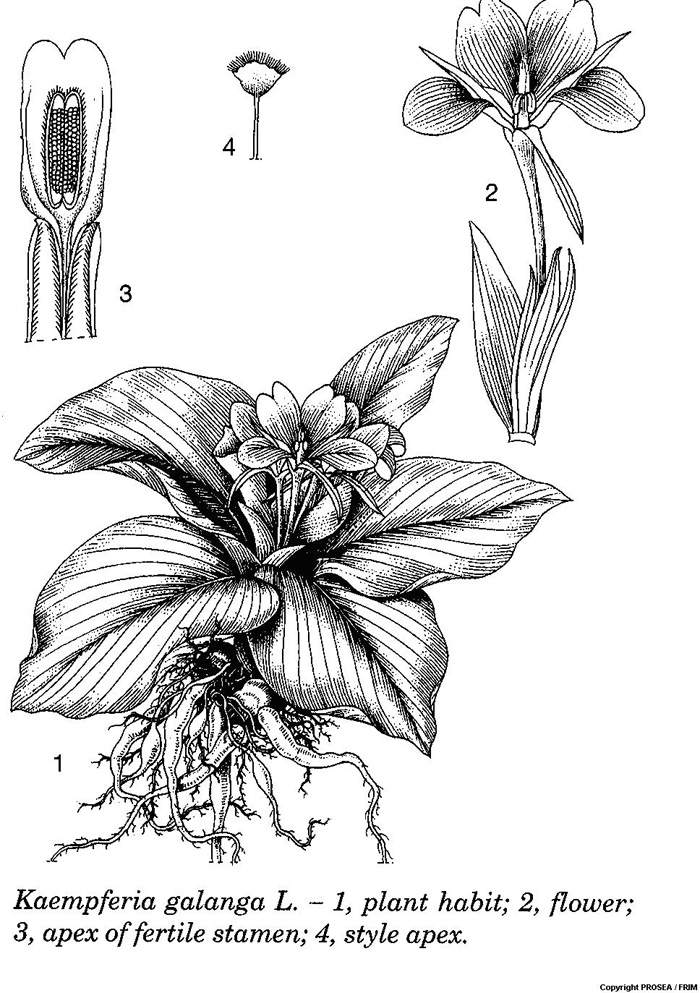
References
- The Plant List. Ver1.1. Kaempferia galangal L.[homepage on the Internet] .c2013 [updated 2012 Mar 26; cited 2016 Apr 21] Available from: http://www.theplantlist.org/tpl1.1/record/kew-250781
- Seidemann J. World spice plants: Economic usage, botany, taxonomy. Berlin: Springer-Verlag, 2005; p. 191.
- Zakaria M, Mohd MA. Traditional Malay medicinal plants. Kuala Lumpur: Institute Terjemahan Negara Malaysia, 2010; p. 133.
- Khare CP. Indian medicinal plants: An illustrated dictionary. Berlin: Springer-Verlag, 2007; p. 351.
- But PPH, Kimura T, Guo J, Sung CK, editors. International collation of traditional and folk medicine: Northeast Asia part II. Singapore: World Scientific, 1997; p. 209.
- Kamaruddin, H. Cekur (Kaempferia galanga L.). In: Penanaman tumbuhan ubatan & beraroma. Serdang, Selangor: MARDI, 2006; p. 8-13
- Ibrahim H. Kaempferia galanga L In: de Padua LS, Bunyapraphatsara N, Lemmens RHMJ, editors. Plant Resources of South-East Asia No. 12(1): Medicinal and poisonous plants 1. Leiden, Netherlands: Backhuys Publisher, 1999; p. 334-335.
- Othman R, Ibrahim H, Mohd MA, Mustafa MR, Awang K. Bioassay-guided isolation of a vasorelaxant active compound from Kaempferia galanga L. Phytomedicine. 2006;13(1-2):61–66.
- Sirisangtragul W, Jarukamjorn K, Nemoto N, Yenjai C, Sripanidkulchai B. Effect of ethyl-p-methoxy cinnamate from Kaempferia galanga on cytochrome P450 enzymes expression in mouse hepatocytes. Chiang Mai J Sci. 2011; 38(3):453–462.
- Sukari MA, Mohd Sharif NW, Yap ALC, et al. Chemical constituent variations of essential oils from rhizomes of four Zingiberaceae species. Malays J Anal Sci. 2008;12(3):638–644.
- Kumar A. Chemical composition of essential oil isolated from the rhizomes of Kaempferia galanga L. Int J Pharm Bio Sci. 2014;5(1):225–231.
- Sahoo S, Parida R, Singh S, Rabindra N, Padhy, Nayak S. Evaluation of yield, quality and antioxidant activity of essential oil of in vitro propagated Kaempferia galanga Linn. J Acute Dis. 2014;3(2):124–130.
- Tewtrakul S, Yuenyongsawad S, Kummee S, Atsawajaruwan L. Chemical components and biological activities of volatile oil of Kaempferia galanga Linn. Songklanakarin J Sci Technol. 2005;27(2):503–507.
- Peter KV, editor. Handbook of herbs and spices. Volume 2. Cambridge: Woodhead Publishing Limited, 2004; p. 83-85.
- Gyatso T, Hakim C. Essentials of Tibetan Traditional Medicine. Berkeley, California: North Atlantic Books, 2010; p. 223.
- Ko HJ, Kim HJ, Kim SY, et al. Hypopigmentary effects of ethyl P-Methoxycinnamate isolated from Kaempferia galanga. Phytother Res. 2014:28(2):274-279.
- Huang L, Yagura T, Chen S. Sedative activity of hexane extract of Keampferia galanga L. and its active compounds. J Ethnopharmacol. 2008;120(1):123-125.
- Umar MI, Asmawi MZ, Sadikun A. Bioactivity-guided isolation of ethyl-p-methoxycinnamate, an anti-inflammatory constituent, from Kaempferia galanga L. extracts. Molecules. 2012;17(7):8720-8734.
- Vittalrao AM, Shanbhag T, Kumari M. Evaluation of antiinflammatory and analgesic activities of alcoholic extract of Kaempferia galanga in rats. Indian J Physiol Pharmacol. 2011 Jan-Mar;55(1):13-24.
- Sulaiman MR, Zakaria ZA, Daud IA, Ng FN, Ng YC, Hidayat MT. Antinociceptive and anti-inflammatory activities of the aqueous extract of Kaempferia galanga leaves in animal models. J Nat Med. 2008;62(2):221-227.
- Ridtitid W, Sae-Wong C, Reanmongkol W, Wongnawa M. Antinociceptive activity of the methanolic extract of Kaempferia galanga Linn. in experimental animals. J Ethnopharmacol. 2008;118(2):225-230.
- Tara Shanbhag V, Chandrakala S, Sachidananda A, Kurady BL, Smita S, Ganesh S. Wound healing activity of alcoholic extract of Kaempferia galanga in Wistar rats. Indian J Physiol Pharmacol. 2006;50(4):384-390.
- Xue Y, Chen H. [Study on the anti-carcinogenic effects of three compounds in Kaempferia galanga L]. Wei Sheng Yan Jiu. 2002;31(4):247-8,251. Chinese.
- He ZH, Yue GG, Lau CB, Ge W, But PP. Antiangiogenic effects and mechanisms of trans-ethyl p-methoxycinnamate from Kaempferia galanga L. J Agric Food Chem. 2012;60(45):11309-11317.
- Othman R, Ibrahim H, Mohd MA, Awang K, Gilani AU, Mustafa MR. Vasorelaxant effects of ethyl cinnamate isolated from Kaempferia galanga on smooth muscles of the rat aorta. Planta Med. 2002;68(7):655-657.
- Othman R, Ibrahim H, Mohd MA, Mustafa MR, Awang K. Bioassay-guided isolation of a vasorelaxant active compound from Kaempferia galanga L. Phytomedicine. 2006;13(1-2):61-66.
- Achuthan CR, Padikkala J. Hypolipidemic effect of Alpinia galanga (Rasna) and Kaempferia galanga (Kachoori). Indian J Clin Biochem. 1997;12(1):55-58.
- Kanjanapothi D, Panthong A, Lertprasertsuke N, et al. Toxicity of crude rhizome extract of Kaempferia galanga L. (Proh Hom). J Ethnopharmacol. 2004 Feb;90(2-3):359-365.


